Beyond Tellerrand - Play - Specialmoves

Beyond Tellerrand - Play
Specialmoves Labs
After spending a lovely week in the city of Cologne, thought I may as well summarise and give my thoughts on what I loved about my trip early, before I forgot. It wasn’t just a fun trip to a lovely city sightseeing and checking out the massive cathedral (even though it was amazing); it was more to see what the Beyond Tellerrand Play conference was about. After browsing around looking for cool conferences to go to this year, this was one of the ones I thought suited me and just by looking at the line-up of speakers, I knew this was a must see.
In the past this was known as Flash Forum Konferenz, but as we all know by now, most well-known conferences are being rebranded and renamed, the main cause of this being the word ‘Flash’. Technology is moving very quickly and now we know Flash isn’t the only technology that can build awesome web interactive applications; conference organisers like Marc Thiele want to emphasize this and show developers what other options are out there to develop cool technology.
Let’s begin to see what I found and learnt from the conference, I will keep it nice and summarised so it doesn’t bore you too much. I will only go through the highlights of each day rather than talking about each talk I went to, there is just too much to talk about.
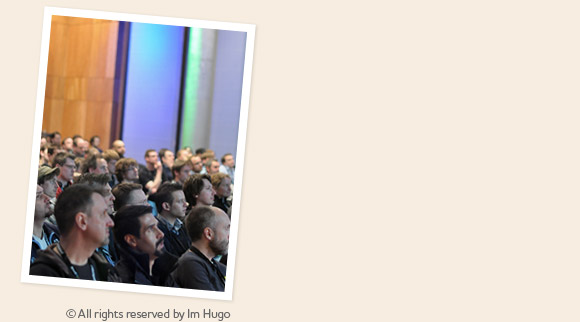
Day 1
ASFEAT – ActionScript Computer Vision
Eugene Zatepyakin
This talk by Eugene was really interesting and the content was superb. He was talking about different ways of detecting image points and using the information to localize predefined image patterns. He used many different AS3 libraries like IN2AR and ASFEAT to help create the Augmented Reality demos he showed.
Most of the demos he presented were really cool; anything that uses AR tend to be really awesome. He had a card with an image on it and when he showed it to a webcam, objects appeared and objects were floating around in the application. He made it look so simple and the performance was brilliant.
One of his coolest demos was Augmented Reality lights, this allowed the framework to pick up light sources in the real world and render the light to your objects in the 3D scene. Another one was when he showed an iPad in the scene with a demo of a car, and had it change into a really simple game controlled by the image pattern.
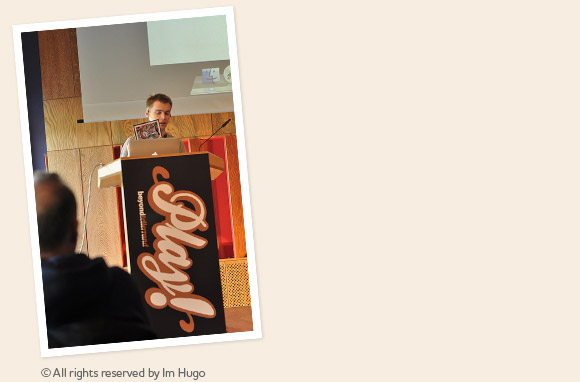
Cutting Edge Flash and Gaming
Tom Krcha
I thought I’d check out what's happening with Adobe and what they're working on for Game developers. It was an interesting talk, though there wasn’t anything technical or content on how to build games; more about what people were developing with Stage3D capabilities.
The talk pretty much promoted how awesome Stage3D is by showing demos of games that people around the world were developing. All I can say is that there is some really good content out there now, proving how developers can build cutting edge games with Flash utilising Stage3D. Tom started to show and emphasise what people in China were developing with Stage3D and all their work looks really promising.
Playing With Chaos
Keith Peters
Now this talk was really good; I would say it was the best talk throughout the conference. Keith was talking about Fractals and a lot of complex maths, but it was all fun. I always enjoy a bit of maths so this talk was perfect for me, and it's one you don’t see every day. It wasn’t just long equations and big numbers, but also visual effects on a computer with these algorithms.
The demos were really impressive and you can find them all here. I really liked how Keith told us the rules for the program, and with some maths it can create some really awesome graphics.
The coastline demo was also amazing; being able to draw random coastlines can give you a random terrain, which reminded me of the game 'Worms'. You can also draw islands; each island can end up a different shape and size, and these would make a great parallax scrolling game.
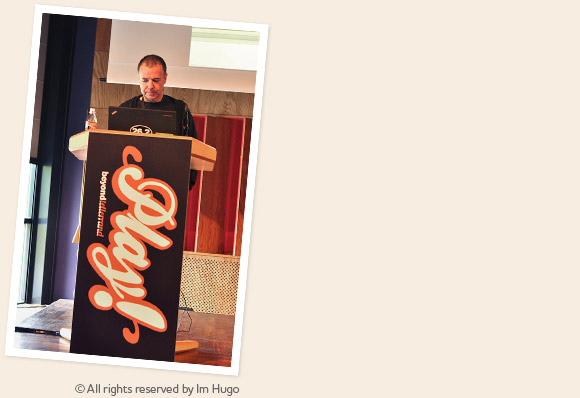
Day 2
Workflows for developing next-gen 3D browser games
Michael Plank
This talk was about back to basics with 3D development and workflows for a game, but also showing the power of Stage3D. Michael showed us most of the basics of 3D like back face culling, Z buffer, camera projections, left and right hand coordinate systems, pixel and vertex shaders and texture mapping. We then all had a glimpse of Delta Strike and it was very impressive. The graphics were really pretty and the performance was phenomenal. He even had it running on the iPad too which just shows how great Stage3D is.
He went through the workflow of how Delta Strike was developed; it was really interesting to see how the concept designs were produced; only spending 2 minutes to draw each ship and then ending up with a sheet of spaceship designs was really cool. Then he showed us all how he was able to produce a 3D model of one of the spaceship designs, with texture maps, specular map and a normal map, which makes the spaceship very detailed when light shines onto the model.
Overall it felt like I was back at University, which was a nice feeling. Even though I learnt most of the content and 3D concepts back in University, it was good to finally get caught back into the basics of 3D and understand the fundamental concepts, which will give me the inspiration to finally develop an awesome 3D game.
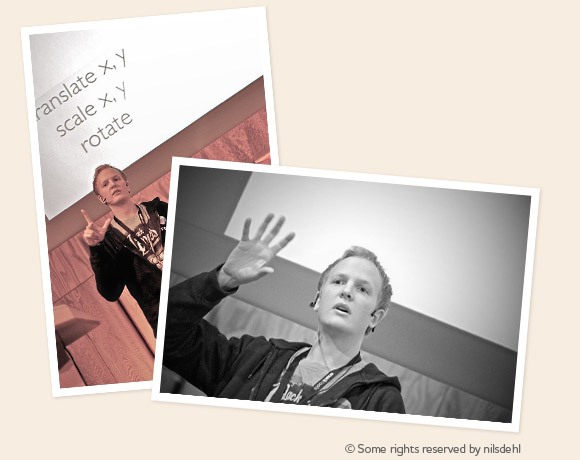
You want to do WHAT with JavaScript
Sebastian Golash
I don’t know much about JavaScript; I can pretty much say I’ve not touched any JavaScript yet, so this talk was pretty interesting in showing what you can really do with it. The presentation was really cool and he was using his mobile device to control the presentation, something I did when I did my Elevator Pitch at Flash on the Beach 2011. He showed some really good demos on what can be done with JavaScript using Sockets.
The first demo was image and video, the image was good and it worked well, but the video was lacking a little bit. It was slow, jerky and lagging, something that will really annoy you if you were playing a game like World of Warcraft. It was just a concept though and would really woprk with some improvements. He also showed a demo using the Arduino, which simply used a twitter feed to determine good and bad comments, and lit certain LEDs depending on the comment. He also showed some code samples, and since I'd never used JavaScript before, it was really impressive, and seemed really simple and easy. With a few lines of code you can have a good demo and app working.
The overall talk was great and does inspire you to develop a cool application and system using JavaScript. Also it was interesting to compare his work to my own, as most of the demos he showed were similar work that I’ve developed and worked on before using Flash, so it was nice to see other developers innovating and building interactive systems.
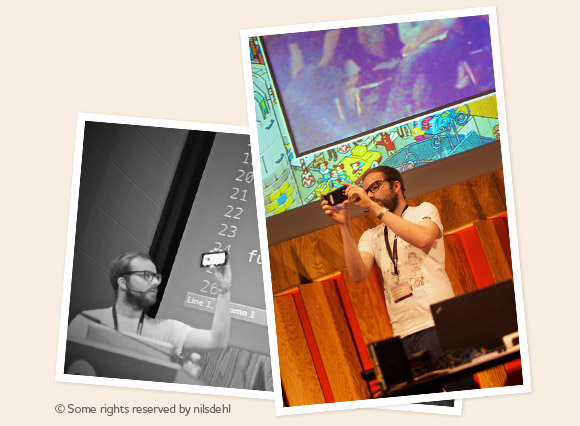
Pixels for the People
Seb Lee-Delisle
Well, this was something to look forward to, as I’d already seen this talk last year at Flash on the Beach. It’s always awesome when Seb does this talk, it’s really inspirational and very clever. He started off by setting a little challenge for the audience, asking what ‘//’ means: whoever knew the answer won a BlackBerry Playbook. Technically I could have won this, as I had already heard the talk before, but that would have been unfair. It was nothing to do with me actually forgetting the answer … O.o
Seb then started to explain the project which was converting each member of the audience phone connected to his server, into a single pixel to create a large scale display. He explained how it worked and what problems he came across that he had to solve. He explains most of the how it all works here, and one of the interesting problems he had was finding people's locations and the way he did this was to had a camera looking at the audience picking up the bright pixels from their devices. The devices then start flashing and the server read those signals to determine the location of the pixel phone. This was really complicated and I can’t say that I understand fully how it was done, but it was a clever way of finding the location of people’s devices.
Once he got the idea across to the audience on how it all worked, it was time for a little bit of fun. Once most of the members of the audience were connected and their location was found, Seb started some demos, firstly having a nice rainbow effect across the room which looked really pretty. Then he had a blue square moving across the audience, and with his syncing system it was really smooth and looked really awesome.
Now then, those demos are cool, but he couldn’t help himself but to make it into a little game where the audience could play . Basically it was time to chase the Nyan Cat, as the cat travelled round on everyone’s device and players had to tickle it as quick as possible when they saw it. Sounds simple and this was my second time playing it, but I came 30th. Marlon, another Specialmover, came 1st and won himself a BlackBerry Playbook ( but only because I gave him a heads up).
Overall this was a really awesome talk and was really fun. I’ve seen a few talks by Seb and they always tend to be creative, innovative, inspirational and just good fun. I did bump into to Seb on Day 1, the day before his talk, so I knew what he was planning to do. He told me to use a phone rather than an iPad during his demo; unfortunately it didn't work at all on my Blackberry Torch, so I had to resort to my iPad after all. That didn't stop me sucking at Nyan Cat.
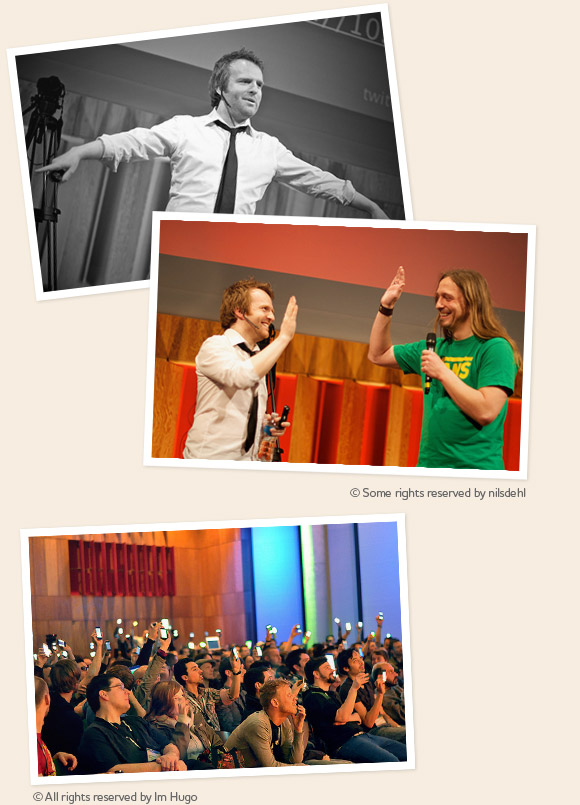
Inspiring
Beyond Play
Joshua Davis
Joshua Davis is an inspiring man; he was last year at Flash on the Beach and still is at Play. He has the ability to make his subject matter fun and make the audience laugh and smile. I know at the time we all got free beer, but I can say for sure that it was his awesome talk, jokes and his swearing that gave everyone the giggles, rather than the alcohol.
Joshua was talking about how work and play are different aspects in life and whether people understand what work is and what play is. We as people have different perspectives of the understanding of work and play, so what happens when we are asked what the opposite of work is? Adults tends to state that if were not working we must be playing. Which brings up the question, is play opposite to work?
To answer it, he began to talk about his work and how he gets inspiration from things he sees around the world or even in Marc Thiele’s basement. He was able to convert the basement's simple floor tiling into creative art on paper, which he ended up using for a book cover, and made some money on. From looking at a floor tiling in a basement he ended up making art, and turning it into work for a book cover.
Joshua loves skateboarding; he loves it that much he has built his own half pipe in his own back garden, which is just awesome. Since he loves skateboarding and has loads of skateboards of his own, he has now ended up doing his own custom art work for skateboards. Obviously doing it digitally wouldn’t be easy, so he has to hand draw the content onto the boards, and they look great. I wouldn’t mind acquiring one to hang in my living room.
Overall, thorugh his own work, he ended up showing everyone how work and play can be the same thing. He loves doing art, he loves experimenting with his various inspirations, and he loves technology, so he ends up constantly playing with the things he loves and end up making it into work, much like his skateboards.
This talk was very inspirational and motivating, and makes you reflect on questions like: Do I enjoy my work? Do I enjoy what I’m doing? Am I still inspired by technology? At the end of the day we choose our jobs, we choose our roles, we decide on what we want to do in life, but we need to make it enjoyable ourselves and make the right choice, because we all want to play while we work. We'll only understand what work and play really are when we try to make them the same thing.
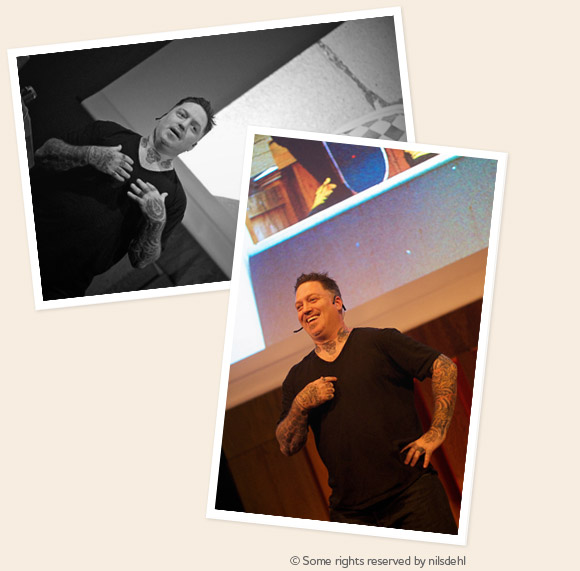
Conclusion
In conclusion the overall conference was very well organised and structured. The layout of the exhibition was really good, and the breaks between talks were really nice to give you a breather. Also, freebees are always nice; I love conference t-shirts, and every time I go to a conference I always try and collect as many as I can. I even ended up asking Marc for one of the green conference t-shirts that all the volunteers were wearing and he was more than happy to give me one.
The overall content of the talks were all perfect for me as a developer, as most of the content was technical. There was a lot about Flash and JavaScript, but I would have loved a little bit of native development for mobile devices, mainly aimed at iOS like Objective-C and Sparrow Framework. We all know how important this area of the market is now, and while AIR can build apps for iOS, it just isn’t the same as native and it’s good to have some knowledge of native development.
I personally learnt a lot from this conference and I am now full of motivation and inspiration to start building my own creative systems, to play with new technology and to make things happen. There is just so much to learn and play with, and if anything, I've realised that I'll have to do more personal projects and work to keep up to date. I ended up catching up with Marc at the end and asked if maybe one day I could do a talk on my work and play... I 'd love to talk about Sparrow Framework next year!
I must thank Marc Thiele for organising such an awesome conference, all the volunteers and all the speakers; it wouldn’t have happened without them. Overall this conference was really good and is by far the best conference I’ve been to. Reasons Festival have their work cut out to be on the same level as Play, but I have faith in them, so I look forward to attending that.
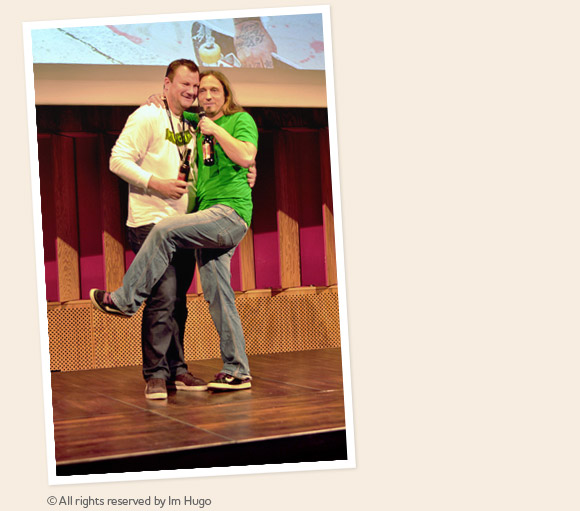
---
Stephen Chan is a developer at Specialmoves and one day hopes to own the worlds largest collection of conference t-shirts. @FatMan_Chan
Follow us on Twitter @specialmoves
